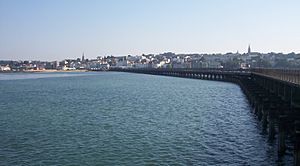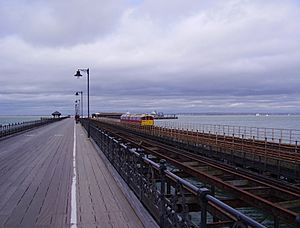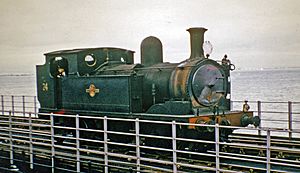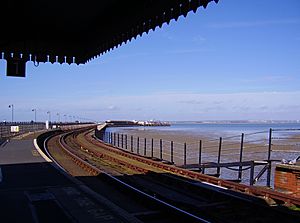Ryde Pier facts for kids

Ryde Pier seen from the pier head, showing the well-known twin spires of Ryde.
|
|
| Official name | Ryde Pier |
|---|---|
| Type | Working pier with landing stages and railway |
| Carries | Cars and Island Line trains |
| Spans | The Solent |
| Locale | Ryde, Isle of Wight |
| Design | John Kent of Southampton |
| Owner | Wightlink (road) / Network Rail (railway) |
| Total length | 745 yards (681 m) |
| Opening date | 26 July 1814 |
Ryde Pier is a very old pier located in Ryde, on the Isle of Wight in England. It was built in the early 1800s. This pier is special because it's the oldest seaside pleasure pier in the world! It helps people get to and from the island. You can find Ryde Pier Head railway station at the end of the pier and Ryde Esplanade railway station closer to the land. Both stations are used by Island Line trains.
Contents
Why Was Ryde Pier Built?
Before the pier was built, getting to Ryde was tricky. Passengers had to be carried on someone's back from their boat to the shore. Then, depending on the tide, they might have to walk a long way across wet sand. This was not very comfortable! People realized that a pier was needed. It would make it easier for visitors, especially wealthy ones, to come to Ryde. This would help the town become a popular seaside resort.
The First Pier
The first part of Ryde Pier was designed by John Kent from Southampton. Its first stone was laid on June 29, 1813. The pier officially opened on July 26, 1814. It had a wooden walkway, just like it does today. This first pier was made completely of timber and was about 576 yards (527 m) long. By 1833, it was made even longer, reaching 745 yards (681 m). This original structure has been used by people and vehicles ever since, with some changes over time.
How Ryde Pier Grew
Over the years, more parts were added to Ryde Pier.
The Tramway Pier
A second pier, called a 'tramway' pier, was built next to the first one. It opened on August 29, 1864. Horse-drawn trams would take passengers from the end of the pier to the town's esplanade. Later, from 1886 to 1927, these trams were powered by electricity. After that, they used petrol until 1969.
The Railway Pier
On July 12, 1880, a third pier was opened. This one was for trains! It provided a direct train link to the pier-head. This railway was part of a bigger railway system. It connected Ryde to other places like Portsmouth by ship. Trains from different companies also used this line to go to towns like Ventnor and Cowes.
Pier Head Changes
In 1895, a concert hall was built at the end of the pier. Over the next 16 years, the original wooden supports of the pier were replaced with stronger cast iron ones. The pier head was updated again in the 1930s using concrete. During the Second World War, the pier was used for military purposes after some changes were made to it.
The old tramway closed in 1969. Part of its structure was taken down. This left a disused and decaying tramway pier between the railway and the main walking pier. This old structure has sometimes been used for temporary walkways. For example, in 1974, a ship hit the main pier, and the old tramway was used as a path. In 2010, it was used again while the main pier was being rebuilt.
Ryde Pier was recognized as a Grade II listed building in 1976. This means it's an important historical structure. In the early 1980s, new waiting areas were built at the pier-head. More updates happened in 2009, including a new refreshment area with great views. In 2011, the lights on the walking pier were changed to look more like the old Victorian style.
Ryde Pier Today
Ryde Pier is still very busy today! It's a main way for people to travel to and from the Isle of Wight. The Island Line train runs from Ryde Pier Head railway station at the end of the pier. It goes through Ryde Esplanade and down the eastern side of the island. The Wightlink catamaran also travels regularly between Ryde and Portsmouth. You can even drive your car along the pier and park at the pier head.
People can still walk along the pier, but they share the wooden walkway with cars. From the end of the pier, you get amazing views across the Solent towards Portsmouth, which is about four miles away. On clear days, you can even see Fawley and its Refinery to the west.
In 2014, Ryde Pier celebrated its 200th birthday! Network Rail plans to invest £5m to upgrade the railway pier. This will help keep the railway running for many more years.
Victoria Pier: Ryde's Other Pier
For a while, Ryde had a second pier called the Victoria Pier. It was a few hundred yards to the east of the main Ryde Pier. This pier opened in 1864. It was built to serve a different ferry service from Gosport. However, it was shorter than Ryde Pier and couldn't be used at all tide levels. This meant it wasn't a strong competitor to the main ferry services.
When the company that owned Victoria Pier was bought by another railway company in 1875, the ferry service stopped. Victoria Pier then became a pleasure pier only. It had public baths at its end and a swimming platform.
By 1900, fewer people were using the bathing facilities. The second pier slowly became old and unused. During the First World War, it was seen as unnecessary and dangerous. In 1916, it was decided that it should be taken down. By the 1920s, it was completely gone. For many years, you could still see parts of where it connected to the shore. At low tide, you could even see the old wooden stumps in the sand.
The Pier Hotel
The Royal Pier Hotel was built soon after the first pier opened. It was meant to serve all the new people coming to the pier. It stood on Pier Street for 100 years and was a well-known building in the area.
The hotel was located at a tricky 90-degree turn for drivers coming down Union Street. In 1930, a bus went too fast around this turn. It overturned, sadly killing some passengers and people on the street. The bus also damaged the hotel. During the investigation, the Pier Hotel was found to be a danger to drivers. Instead of being fixed, it was ordered to be torn down. By 1931, the Pier Hotel and other nearby buildings were removed. Pier Street itself no longer existed and became part of the Esplanade.
Images for kids





